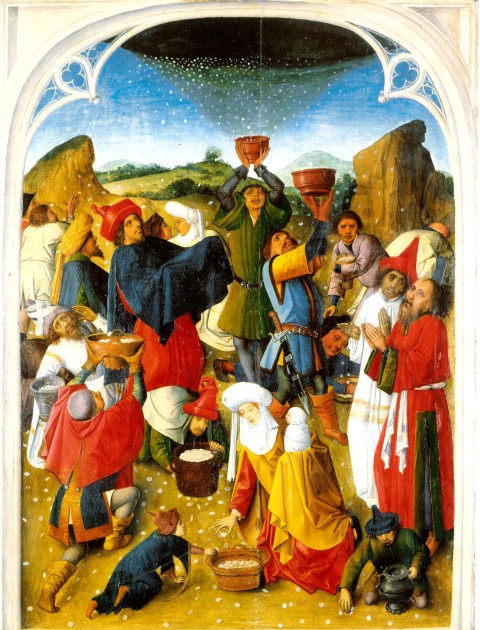The manna story (John 6:24-35; Exodus 16:2-4, 9-15; Ephesians 4:1-16)
What is manna? Is it a Hebrew pun on mah hu, or as Everett Fox suggests, “Whaddayacallit”? Is it mountains of sweet insect excrement, as proposed by some scholars, or the stuff of legend?

Many preachers, facing the summer lectionary in Year B, ask why there are five weeks of John 6. The simplest answer is that the first draft of this three-year lectionary was designed by Roman Catholics, who treasure this chapter and enact it in their daily Eucharist. Subsequent revisions of the lectionary sought to keep at least the Gospel readings untouched. Perhaps some clergy think, well, it’s summertime and most people will miss half the Sundays anyway. But I, who am not a preacher, attend church on all these five Sundays and am glad that my national church, in its use of the Revised Common Lectionary, selects the option of complementary readings: the first reading always in some way connects with the Gospel. In this case, the Gospel of John, as it teaches about bread from heaven, keeps company with those passages from the Hebrew scriptures that the evangelist assumed the hearers knew: “Scripture interprets scripture” is a good place to start.
What is manna? Is it a Hebrew pun on mah hu, or as Everett Fox suggests, “Whaddayacallit”: What is this stuff? Is manna mountains of sweet insect excrement, as proposed by some scholars, or the stuff of legend, of a tale told over the generations about how, in some mysterious way, God gives us life? The New Testament’s version of this question is “Who is he?”—and Christians have told one another, over the generations, that in some mysterious way he is the life that God gives. Our manna is Christ.
The Exodus 16 narrative sounds like a weather report. The manna rains from heaven, which of course means from the sky. The morning dew leaves behind a residue like frost, as God appears to the people in a cloud. For God to be in a cloud in this place with scarce rain testifies that God is the one from whom all blessings flow. Our cloud is God. Recently liturgical scholars who are urging us to revive the use of the ancient Easter Vigil are once again attending to the cosmos: Easter is the first Sunday after the full moon after the spring equinox, the annual celebration of our passover from death to life computed from the movements of what used to be called the heavenly bodies. This is not so far off from God as a cloud: the resurrection as the confluence of sun and moon and earth, Christ as Mother Earth. The food from God is seen as one with nature, as the water of rain and dew and frost and cloud contain divine mercy.
The manna that comes is always enough for the day. Give us this day our daily bread. But we are all worried now about our retirement funds. Can I quit working at 65 as planned? Is it OK to imagine ourselves perpetually as the Israelites on the sixth day, gathering up a double portion?
Medieval artists depicted this narrative as if the manna raining down from the clouds were round communion wafers. This iconographic tradition is not our style of ecclesiastical art—and for heaven’s sake, can we finally be done with prepackaged communion hosts that resemble nothing? The point is real bread. But I appreciate what the art was conveying: Christians attend to the stories of the Hebrew scriptures, John referring to Christ as the Bread that comes down from heaven, because the baptized community relies on Old Testament vocabulary to speak its metaphors. These are the best metaphors we have. So who is he? He is Manna, Bread graciously provided to us as we slog through our wilderness. John always borrows the Jewish vocabulary to speak of Christ: Christ is the first light of creation, the lamb, the rabbi, the anointed one, the temple, the water from the rock, the gate to the sheepfold.
Unless we use these stories as pictures of the Christian life, likening Jesus to Jonah in the belly of the fish, why would we tell these tales? (Those of you with the semicontinuous readings from the Hebrew scriptures: what do you do this week with God approving a polygamous wife-swapping venture and the death of an infant to punish an adulterous father? Well, let’s see: David as the flawed king, Christ as the unflawed king, allowing for his own death, rather than the murder of the other, to ensure life, not for himself but for the people.) Whether or not there was a King David, or nomads who ate bizarre food, we are that David, misusing our power. We are those Israelites, hoping that God will continue to provide food for our tables, recognizing Christ in the bread served at Holy Communion.
I wonder if the evangelist of John read the Gospel of Mark and decided that the mystery of Christ simply needed crazier language. So if we eat of Christ, if we, one body, share in the one body, we will never be hungry, we will never be thirsty. A recent Lutheran worship book renders a thanks giving to be prayed over the baptismal font: “The Israelites . . . drink from your gushing rock, . . . and the Samaritan woman will never be thirsty again.” Our faith is beyond human languages, our God is not only within but outside our brains’ categories, and so we need these metaphors. The manna story helps us to affirm that God comes to us in Christ; that what we need of heaven is here in the body of Christ among whom we gather each week; that this bread, baked by Clarence or bought at Safeway on our way to church this morning, is mysteriously life from God.




